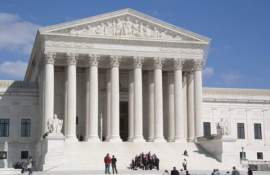
Brandenburg v. Ohio

The Background of Brandenburg v. Ohio (1969)
Clarence Brandenburg was a member of the Ku Klux Klan located in the outskirts of Cincinnati, Ohio; upon the organization of a county Ku Klux Klan rally, Brandenburg contacted a local news publication in Cincinnati in order to invite them to cover the events taking place. The news arrived at the rally and filmed the events taking place, which resulted in the broadcast of racist, derogatory, and objectionable hate-speech on television. Following a multitude of complaints, Brandenburg was arrested as a resulted of a presumed violation of an Ohio statute prohibiting the syndication of expression and speech deemed to be objectionable, violent, and offensive; Brandenburg disputed the charges explaining that his actions were absent of criminal intent:
The notion of criminal intent – or the intention to commit a crime – is explored in trials and lawsuits that involve charges of both free speech, as well as the violation of free speech; as a result, the freedom of expression latent within the 1st Amendment of the Constitution requires the permissibility of free speech in the event that it is devoid of criminal intent or illegal recourse
The Case Profile of Brandenburg v. Ohio
The following is a case profile of the legal trial eponymously titled ‘Brandenburg v. Ohio’:
Date of the Trial: February 27th, 1969
Legal Classification: Administrative Law; this legal field regulates ‘due process’, which is defined as the government’s obligation to respect, maintain, and uphold the legal rights of its citizens in the event of an arrest. Both the Federal and State government must preserve and protect an individual’s human rights and liberties; this includes fair, respectful, and ethical treatment devoid of undue violence and harm
Accused Criminal Activity: The following criminal activity and charges were cited by Clarence Brandenburg against the State of Ohio within the appeal brought forth subsequent to the initial ruling:
Brandenburg maintained that his 1st Amendment Rights had been violated due to his arrest, which was due to the fact that he had been punished for non-violent and non-criminal expression
United States Reports Case Number: 395 U.S. 444
Date of the Delivery of the Verdict: June 9th, 1969
Legal Venue of Brandenburg v. Ohio: The Supreme Court of the United States
Judicial Officer Responsible for Ruling: Chief Justice Earl Warren
Involved Parties: The following are the parties named with regard to their involvement in the Brandenburg v. Ohio case:
Clarence Brandenburg; Plaintiff - Brandenburg v. Ohio
The State of Ohio; Defendant - Brandenburg v. Ohio
Verdict Delivered: The Supreme Court ruled in favor of Brandenburg, stating that the Ohio statute prohibiting the syndication of speech and expression deemed to be objectionable was violation of the 1st Amendment to the Constitution. Within their ruling, the Supreme Court distinguished the difference between implied violence and violent acts; although there existed arguable latent violence within the events of the Ku Klux Rally, the sentiments expressed were not considered to be of immediate danger, threat, or harm
Associated Legislation with regard to Brandenburg v. Ohio: The following statutory regulations were employed with regard to the Brandenburg v. Ohio trial:
The 1st Amendment of the Constitution of the United States ensures that every American citizen be granted the freedom to express themselves in accordance with applicable legislature enacted in order to preserve the safety and wellbeing of the general public; however, the right to free speech prohibits ideas, ideology, or creeds to be imposed on any individual without their respective and expressed consent. Contact Ohio lawyers for legal advice and assistance.
NEXT: Brown v. Mississippi




















